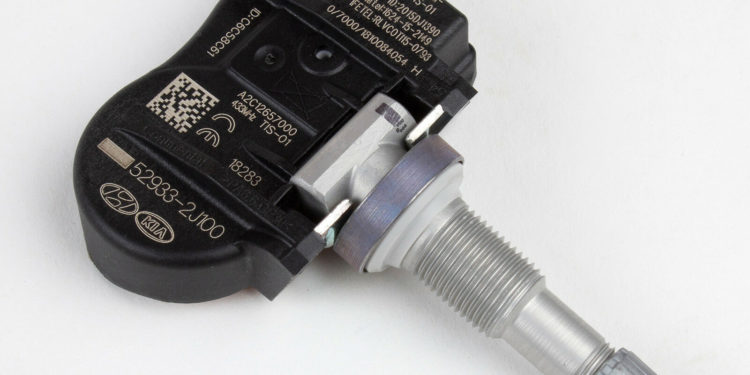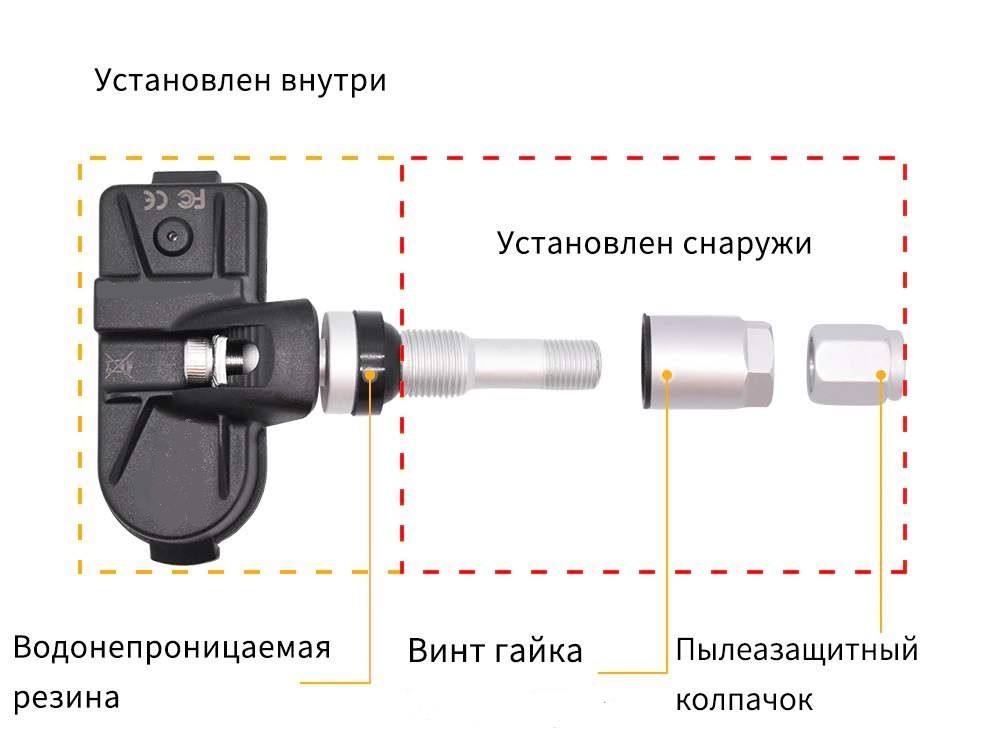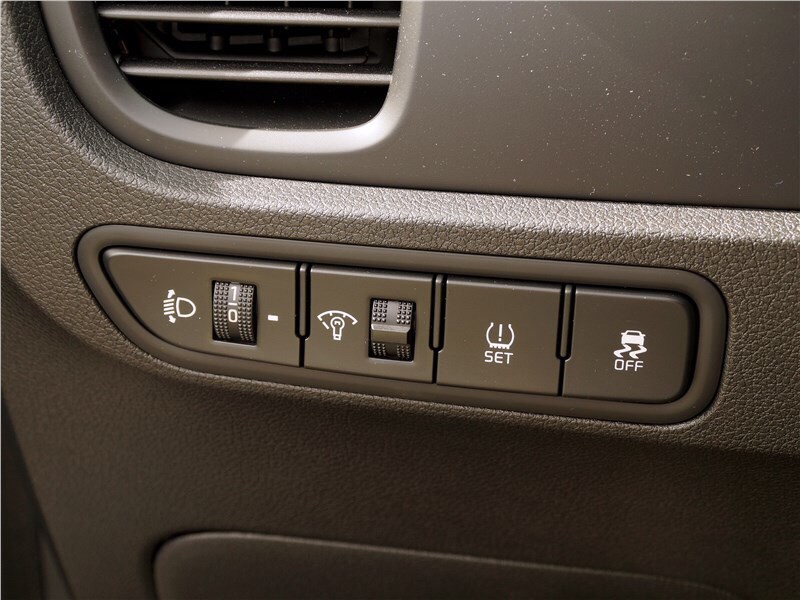Kia tire pressure monitor
(1) Low tire pressure telltale / TPMS malfunction indicator
Each tire, including the spare (if provided), should be checked monthly when cold and inflated to the inflation pressure recommended by the vehicle manufacturer on the vehicle placard or tire inflation pressure label. (If your vehicle has tires of a different size than the size indicated on the vehicle placard or tire inflation pressure label, you should determine the proper tire inflation pressure for those tires.)
As an added convenience feature, your vehicle has been equipped with a tire pressure monitoring system (TPMS) that illuminates a low tire pressure telltale when one or more of your tires is significantly underinflated.
Accordingly, when the low tire pressure telltale illuminates, you should stop and check your tires as soon as possible, and inflate them to the proper pressure. Driving on a significantly under-inflated tire causes the tire to overheat and can lead to tire failure. Under-inflation also reduces fuel efficiency and tire tread life, and may affect the vehicle’s handling and stopping ability.
Please note that the TPMS is not a substitute for proper tire maintenance, and it is the driver’s responsibility to maintain correct tire pressure, even if under-inflation has not reached the level to trigger illumination of the TPMS low tire pressure telltale.
Your vehicle has also been equipped with a TPMS malfunction indicator to indicate when the system is not operating properly. The TPMS malfunction indicator is combined with the low tire pressure telltale. When the system detects a malfunction, the telltale will flash for approximately one minute and then remain continuously illuminated. This sequence will continue upon subsequent vehicle start-ups as long as the malfunction exists. When the malfunction indicator is illuminated, the system may not be able to detect or signal low tire pressure as intended. TPMS malfunctions may occur for a variety of reasons, including the installation of replacement or alternate tires or wheels on the vehicle that prevent the TPMS from functioning properly.
Always check the TPMS malfunction telltale after replacing one or more tires or wheels on your vehicle to ensure that the replacement or alternate tires and wheels allow the TPMS to continue to function properly.
If the TPMS, Low Tire Pressure indicator do not illuminate for 3 seconds when the ignition switch is turned to the ON position or engine is running, or if they remain illuminated after coming on for approximately 3 seconds, take your vehicle to your nearest authorized Kia dealer and have the system checked.
Low tire pressure telltale
When the tire pressure monitoring system warning indicators are illuminated, one or more of your tires is significantly under-inflated.
If the telltale illuminates, immediately reduce your speed, avoid hard cornering and anticipate increased stopping distances. You should stop and check your tires as soon as possible.
Inflate the tires to the proper pressure as indicated on the vehicle’s placard or tire inflation pressure label located on the driver’s side center pillar outer panel. If you cannot reach a service station or if the tire cannot hold the newly added air, replace the low pressure tire with the spare tire.
Then the Low Tire Pressure telltale may flash for approximately one minute and then remain continuously illuminated after restarting and about 20 minutes of continuous driving at speed above 15.5 mph (25 km/h) before you have the low pressure tire repaired and replaced on the vehicle.
In winter or cold weather, the low tire pressure telltale may be illuminated if the tire pressure was adjusted to the recommended tire inflation pressure in warm weather. It does not mean your TPMS is malfunctioning because the decreased temperature leads to a proportional lowering of tire pressure. When you drive your vehicle from a warm area to a cold area or from a cold area to a warm area, or the outside temperature is greatly higher or lower, you should check the tire inflation pressure and adjust the tires to the recommended tire inflation pressure.
WARNING — Low pressure damage
Significantly low tire pressure makes the vehicle unstable and can contribute to loss of vehicle control and increased braking distances. Continued driving on low pressure tires can cause the tires to overheat and fail.
TPMS (Tire Pressure Monitoring System) malfunction indicator
The TPMS malfunction indicator will illuminate after it blinks for approximately one minute when there is a problem with the Tire Pressure Monitoring System. Have the system checked by an authorized Kia dealer as soon as possible to determine the cause of the problem.
- The TPMS malfunction indicator may blink for approximately 1 minute and then remain continuously illuminated if the vehicle is moving around electric power supply cables or radios transmitters such as at police stations, government and public offices, broadcasting stations, military installations, airports, or transmitting towers, etc. This can interfere with normal operation of the Tire Pressure Monitoring System (TPMS).
- The TPMS malfunction indicator may blink for approximately 1 minute and then remain continuously illuminated if snow chains are used or some separate electronic devices such as notebook computer, mobile charger, remote starter or navigation etc., are used in the vehicle. This can interfere with normal operation of the Tire Pressure Monitoring System (TPMS).
- Changing a tire with TPMS
- This device complies with Part 15 of the FCC rules.
Engine overheat
If your temperature gauge indicates overheating, you experience a loss of power, or hear loud pinging or knocking, the engine will probably be too hot. If this happens, you should: 1.Pull off the .
Changing a tire with TPMS
If you have a flat tire, the Low Tire Pressure telltale will come on. Have the flat tire repaired by an authorized Kia dealer as soon as possible or replace the flat tire with the spare tire. CAU .
See also:
To decrease the cruising speed
Follow either of these procedures: Push the SET — switch and hold it. Your vehicle will gradually slow down. Release the switch at the speed you want to maintain. Push the SET — switch and .
Operating door locks from outside the vehicle
Turn the key clockwise to lock and counterclockwise to unlock. If you lock the driver’s door with a key — all vehicle doors will lock automatically. (for normal key) — only the drive .
О датчике давления в шинах Киа Рио
Одна из проблем, с которыми приходится сталкиваться автовладельцам – недостаток информации. Многие слышали про датчик давления в шинах, но не все представляют, как выглядит подобная деталь и есть ли она в принципе на их автомобиле.
Не облегчают ситуацию и данные, публикуемые на разных интернет-ресурсах. Ошибочные или неполные, они нередко вводят автомобилистов в заблуждение. Постараемся, хотя бы частично, устранить имеющиеся информационные пробелы.
Общие сведения
Согласно европейским и американским требованиям безопасности, новые автомобили оснащаются системами контроля давления в шинах. В технической литературе такие устройства обозначают аббревиатурой TPMS (Tire Pressure Monitor System). Их различают по принципу работы, который бывает прямым или косвенным. Разница в следующем:
- Оборудование, работающее по косвенному принципу, получает информацию от датчиков ABS. Очевидно, что диаметр спустившего колеса уменьшается. Эту разницу видит ABS и посылает сигнал на контрольный блок.
- Системы прямого действия функционируют, опираясь на показания специальных датчиков давления, установленных внутри шин.
Постепенно TMPS прямого действия получают всё большее распространение. Дело в том, что оборудование косвенного типа:
- Передаёт показания с большими погрешностями. Для того чтобы на панели приборов загорелась контрольная лампа, давление в покрышке должно упасть на 25 – 30%.
- Срабатывают только после того, как автомобиль начинает движение и проедет определённое расстояние. Пройденного пути может оказаться достаточно для того, чтобы шина оказалась повреждена.
Следовательно, подобное оснащение не избавляет от необходимости регулярно проверять состояние колёс, вооружившись манометром. Его единственное преимущество – низкая стоимость.
И вот тут мы подходим к самому важному. Дело в том, что выпускаемые в настоящее время модели Kia Rio 4 могут комплектоваться TMPS как косвенного, так и прямого действия. И в инструкции по эксплуатации машины нет прямых указаний, какого типа оборудование установлено на машине.
Обнаружить это можно визуально. Регистрирующие перепады давления датчики TMPS прямого действия объединены в единые узлы с сосками ниппелей, форма которых в этом случае отличается от стандартной. Такие соски бывают только металлическими, а на их корпусах присутствует шестигранная насечка под гаечный ключ. Чтобы не было сомнений, рекомендуется произвести осмотр авто ещё при покупке.
Как это работает
О том, что с давлением в шинах что-то не так водитель узнаёт, когда на панели приборов загорается контрольная лампа с пиктограммой в виде поперечного сечения покрышки.
В этом случае следует прекратить движение и произвести внешний осмотр и проверку колёс. Следует помнить, что алгоритм срабатывания TMPS прямого и косвенного действия отличается:
- Первая видит и передаёт показания сразу, как только давление снизилось.
- Вторая получает данные после прохождения расстояния не менее 10 – 12 метров.
Есть и ещё один важный момент. Косвенная TMPS срабатывает, если на машине установлены шины разного диаметра или отличающиеся от одобренных производителем размеров. А ещё в ней иногда возникают глюки. В последнем случае, если вы проверили давление в колёсах манометром и убедились, что всё нормально, а пиктограмма продолжает гореть, рекомендуется сделать следующее:
- Повернуть ключ в замке зажигания в позицию, когда загораются контрольные лампы и раздаётся звуковой сигнал.
- Нажать клавишу SET, расположенную в блоке кнопок, находящемся на панели приборов слева от рулевой колонки.
- Держать клавишу до тех пор, пока контрольная лампа, предварительно мигнув несколько раз, не погаснет.
После этого процедура обнуления показаний системы контроля давления в шинах считается завершённой.
С TMPS прямого действия всё одновременно и сложнее, и проще. Прежде всего, сотрудники шиномонтажа должны действовать аккуратно, чтобы не повредить смонтированное в колёсах оборудование. А ещё нужно иметь в виду, что:
- Датчики могут устанавливаться не на все колёсные диски. Всё дело в размерах посадочного места под сосок ниппеля.
- Если вы намерены приобрести для Киа Рио 4 дополнительный комплект резины вместе с дисками, зимней или летней – не имеет значения, придётся докупать и устанавливать дополнительный комплект оборудования.
- Если производилась замена датчика, его следует прописать в памяти электронного блока управления. Для этого требуется специальное оборудование, подключаемое к диагностическому разъёму автомобиля. Процедуру прописки можно произвести, посетив дилерское СТО или иную мастерскую, имеющую в своём распоряжении необходимое оснащение.
Зато такие устройства чувствительнее и передают точные показания сразу, а не после начала движения. Правда, при их выходе из строя проблема решается только заменой детали.
Подбор запчастей
Датчик TMPS прямого действия (их правильное название – шток-система контроля давления в шинах) представляет собой металлический сосок на нижней части которого закреплён электронный блок, считывающий показания и передающий их с помощью радиосигнала определённой частоты.
Устройство питается от встроенного аккумулятора, срок службы которого составляет 5 – 7 лет. Когда аккумулятор истощается, узел меняется целиком. Необходимые комплектующие продаются в магазинах автозапчастей. Вы можете приобрести:
- Оригинал Hyundai/Kia с каталожным номером 52933-2J Их стоимость колеблется в пределах 2200 – 3500 рублей за штуку.
- Аналоги сторонних производителей. Например, детали тайваньской фирмы Mobiletron за номером TX-S За такие запчасти просят 2200 – 2800 рублей.
Как видите, разница в стоимости невелика, а потому в покупке заменителей особого смысла нет. Какому варианту отдать предпочтение – решайте сами.





